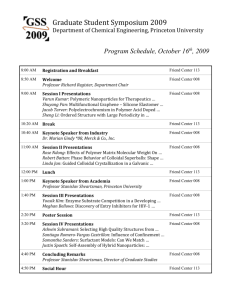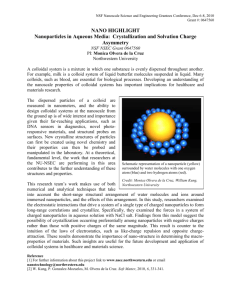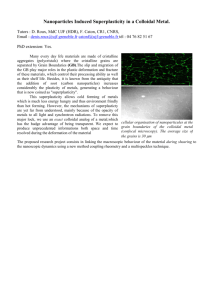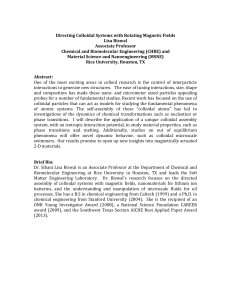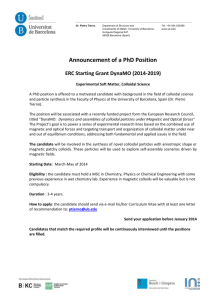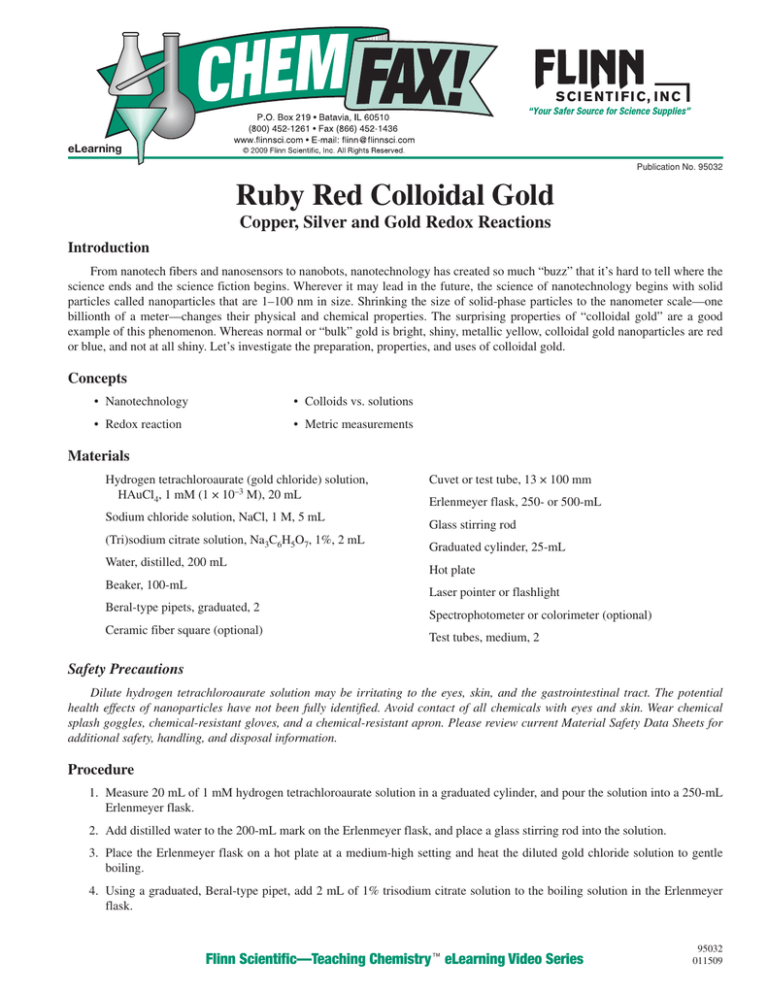
eLearning
2009
Publication No. 95032
Ruby Red Colloidal Gold
Copper, Silver and Gold Redox Reactions
Introduction
From nanotech fibers and nanosensors to nanobots, nanotechnology has created so much “buzz” that it’s hard to tell where the
science ends and the science fiction begins. Wherever it may lead in the future, the science of nanotechnology begins with solid
particles called nanoparticles that are 1–100 nm in size. Shrinking the size of solid-phase particles to the nanometer scale—one
billionth of a meter—changes their physical and chemical properties. The surprising properties of “colloidal gold” are a good
example of this phenomenon. Whereas normal or “bulk” gold is bright, shiny, metallic yellow, colloidal gold nanoparticles are red
or blue, and not at all shiny. Let’s investigate the preparation, properties, and uses of colloidal gold.
Concepts
• Nanotechnology
• Colloids vs. solutions
• Redox reaction
• Metric measurements
Materials
Hydrogen tetrachloroaurate (gold chloride) solution,
HAuCl4, 1 mM (1 × 10–3 M), 20 mL
Sodium chloride solution, NaCl, 1 M, 5 mL
(Tri)sodium citrate solution, Na3C6H5O7, 1%, 2 mL
Water, distilled, 200 mL
Beaker, 100-mL
Cuvet or test tube, 13 × 100 mm
Erlenmeyer flask, 250- or 500-mL
Glass stirring rod
Graduated cylinder, 25-mL
Hot plate
Laser pointer or flashlight
Beral-type pipets, graduated, 2
Ceramic fiber square (optional)
Spectrophotometer or colorimeter (optional)
Test tubes, medium, 2
Safety Precautions
Dilute hydrogen tetrachloroaurate solution may be irritating to the eyes, skin, and the gastrointestinal tract. The potential
health effects of nanoparticles have not been fully identified. Avoid contact of all chemicals with eyes and skin. Wear chemical
splash goggles, chemical-resistant gloves, and a chemical-resistant apron. Please review current Material Safety Data Sheets for
additional safety, handling, and disposal information.
Procedure
1. Measure 20 mL of 1 mM hydrogen tetrachloroaurate solution in a graduated cylinder, and pour the solution into a 250-mL
Erlenmeyer flask.
2. Add distilled water to the 200-mL mark on the Erlenmeyer flask, and place a glass stirring rod into the solution.
3. Place the Erlenmeyer flask on a hot plate at a medium-high setting and heat the diluted gold chloride solution to gentle
boiling.
4. Using a graduated, Beral-type pipet, add 2 mL of 1% trisodium citrate solution to the boiling solution in the Erlenmeyer
flask.
Flinn Scientific—Teaching Chemistry eLearning Video Series
95032
011509
5. Observe the color changes in the solution as gold(III) ions react with citrate. (The pale yellow solution will gradually turn
blue, violet, and then magenta or ruby-red.)
6. Continue heating the solution at a gentle boil for approximately 10 minutes until the solution is ruby- or wine-red and the
color no longer changes.
7. Remove the Erlenmeyer flask from the hot plate. Place the flask on a heat-resistant surface or ceramic fiber square and
allow the solution to cool. Add distilled water to bring the total volume of liquid back up to 200 mL, if necessary.
8. When the solution has cooled to room temperature, pour some of the “colloidal gold” into a small beaker and observe its
properties. (The colloidal gold “solution” is an intense wine-red or reddish violet color. There are no solid-phase particles
visible, but the liquid appears very slightly translucent rather than transparent.)
9. Shine a laser pointer or flashlight through the colloidal gold solution and observe the “path” of the light through the solution. (The beam of light becomes visible as it passes through the solution. This property, called the Tyndall effect, is due to
light scattering.)
10. Discuss what happens when light is shone through a true (transparent) solution such as water. (A true solution is transparent—light passes through the solution and is projected on the other side, but the path of light in the solution itself is not
visible.)
11. Compare and contrast the following properties of a colloid versus a true solution: particle size, settling behavior, filtration,
light scattering. (See the Discussion section.)
12. Pour some of the colloidal gold into two medium-size test tubes, filling each test tube about one-third full.
13. Add an equal volume of distilled water to the first test tube, and an equal volume of 1 M sodium chloride solution to the
second test tube. Carefully swirl each test tube to mix the contents. Observe any color changes of the colloidal gold. (The
original red color of the colloidal gold changes to blue when it is diluted with sodium chloride solution. The red color of
the colloidal gold simply fades to paler shade of red when diluted with water.)
14. (Optional) Fill a cuvet approximately two-thirds full with the colloidal gold solution and measure the absorbance every 10
nm from 400 to 700 nm using a spectrophotometer. (See the Discussion section.)
Disposal
Please consult your current Flinn Scientific Catalog/Reference Manual for general guidelines and specific procedures governing the disposal of laboratory waste. The colloidal gold solution is very stable and may be stored indefinitely. Keep the solution in
a dark bottle to avoid exposure to light. Because of the unknown potential health hazards of colloidal gold, we do not recommend
disposing of colloidal gold down the drain. The colloid may be broken by adding 6 M hydrochloric acid, which precipitates the
gold. Solid gold may be disposed of in the trash according to Flinn Suggested Disposal Method #26a. Excess hydrogen tetrachloroaurate solution should be stored for future use.
Tips
• Using a more concentrated solution of HAuCl4 in the colloidal gold preparation produces a cloudy, dark blue dispersion
of gold nanoparticles. The blue mixture consists of larger particles (ca. 100 nm)—the visible absorbance shifts to longer
wavelength, and there is considerable light scattering.
• The scanning tunneling microscope (STM) is the most important tool for studying the size and shape of nanoparticles.
Using this non-optical, scanning probe microscope, scientists are able to “see” individual atoms and molecules at a resolution of 0.2 nm (2 × 10–10 m). A tiny electrical probe or stylus is moved across a surface, producing a weak electrical
current between the tip and the surface. The locations of atoms on the surface are visualized as regions of high electron
density due to changes in the magnitude of the current or the position of the stylus. Heinrich Rohrer and Gerd Binnig of
the IBM Research Laboratory in Zurich, Switzerland, received the Nobel Prize in Physics in 1986 for their invention of the
STM. Visit the official Web site of the Nobel Foundation at http://nobelprize,org/education_games/physics/microscopes/
scanning/gallery/index.HTML (accessed November 2006) to view an impressive gallery of “atomic” photos obtained with
the STM.
–2–
© 2009 Flinn Scientific, Inc. All Rights Reserved.
95032
Discussion
Nanoscience or nanotechnology involves the preparation, characterization, and uses of nano-sized particles having dimensions in the 1–100 nm range. Nanoparticles have unique physical and chemical properties that are significantly different from the
macroscopic properties of traditional or bulk solids. Many of these properties have taken on special importance in recent years
as the applications of nanotechnology have intensively studied. In particular, the electronic, magnetic, and optical properties of
nanoparticles have proven to be very useful in the creation of new products using nanotechnology. Quantum dots, for example, are
nanocrystalline fluorescent semiconductors that are used in high definition DVD players and video game consoles.
Gold nanoparticles are one of the most widely used materials in nanotechnology, and they are certainly the oldest. Colloidal
gold consists of gold(0) nanoparticles that range in size from approximately 5–50 nm and are uniformly dispersed in water.
Michael Faraday (1791–1867) published a scientific report of the preparation and properties of colloidal gold in 1857, but the
art of using colloidal gold as a decorative pigment in glassmaking dates back more than 1000 years. The Lycurgus Cup at the
British Museum in London, England, a Roman artifact from the fourth century A.D., is the most famous example of ancient “gold
ruby glass.” The presence of tiny, 70-nm crystals of silver and gold “dissolved” in the glass gives the cup a lustrous red appearance when light shines through it. This demonstrates the most striking and beautiful feature of gold nanoparticles—their color.
Depending on the size and shape of the particles, the color of gold nanoparticles varies from red to purple. The optical properties
of gold nanoparticles are not only unique, they are also useful, providing the basis for commercial products such as medical diagnostic kits for HIV detection, biosensors for DNA analysis, lasers, and optical filters. From a chemical standpoint, gold nanoparticles have a very active surface chemistry and are thus valuable catalysts for pollution control, fuel cells, and the synthesis of specialty chemicals. The ability of various electron-donating groups to bind to the surface of gold nanoparticles is being investigated
as a way to direct the self-assembly of complex structures for futuristic nano-computers and other nano-electronic devices.
The most common method for the preparation of colloidal gold involves the reduction of gold(III) ions by citrate ions
in dilute (0.1 mM) aqueous solution. The gold(III) ions are usually added to water in the form of hydrogen tetrachloroaurate
(HAuCl4). Citrate ions (C6H5O73–), which are most likely oxidized to acetone dicarboxylate ions (C5H4O42–) in the process, act as
a two-electron reducing agent. The half reactions for the synthesis of colloidal gold are given in Equations 1 and 2.
Au3+(aq) + 3e– → Au(s)
Equation 1
C6H5O73– (aq) + H2O(l) → C5H4O42–(aq) + CO2(g) + H3O+(aq) + 2e–
Equation 2
The average diameter of gold nanoparticles produced by this method depends on temperature and on the concentration ratio
of gold(III) ions and citrate ions in solution. The gold nanoparticles are stabilized by the presence of citrate ions adsorbed on the
surface of the particles. Adsorption of citrate ions gives the gold particles an overall negative charge and is the principal factor
responsible for the formation of a stable colloid. Mutual repulsion of the small, negatively charged particles prevents them from
coagulating to form larger particles that might eventually settle out of solution.
The visible absorption spectrum of the colloidal gold produced in this demonstration is shown in Figure 1. The wavelength of
maximum absorbance at 520 nm correlates with the formation of gold nanoparticles having an average diameter of 20–40 nm. The
“peak width at half-maximum” for this colloidal gold preparation is quite broad (130 nm) and indicative of a fairly wide distribution
of particle sizes around the mean. In general, the wavelength of maximum absorbance shifts to higher wavelength (>520 nm) when
the mean particle size increases above 40 nm, and the peak width increases when there is a larger variation in particle sizes. The color
change of the gold colloid from red to blue when sodium chloride is added illustrates this effect. Adding NaCl, a strong electrolyte,
shields the negative charges of the colloidal gold nanoparticles and causes them to clump together to form larger particles.
–3–
© 2009 Flinn Scientific, Inc. All Rights Reserved.
95032
0.7
0.6
Absorbance
0.5
0.4
0.3
0.2
0.1
0
400
450
500
550
600
650
700
Wavelength (nm)
Figure 1. Visible Spectrum of Colloidal Gold.
The absorbance of visible light by gold and other metal nanoparticles has been attributed to a unique phenomenon called
surface plasmon resonance (SPR). This phenomenon is very different from the “normal” visible spectrum of colored organic dye
molecules, for example, which is due to the promotion of electrons from the ground state to an excited state when light of a specific wavelength is absorbed. SPR is defined as the “collective oscillation of conduction band electrons resulting from the interaction with electromagnetic radiation.” In laymen’s terms, the incoming electromagnetic radiation induces the formation of a dipole
on the surface of the nanoparticle, which then oscillates in phase or in resonance with the electric field of the incoming light. This
occurs at a specific frequency (and wavelength or color) of light, depending on the size, shape, and form of the nanoparticles. As
noted above, dispersions containing small gold nanoparticles are red. When the nanoparticles begin to aggregate further, their
color changes from red to blue and then to purple.
Solutions and colloids, which differ in the size of the particles that are dispersed throughout a continuous phase, are distinguished from one another primarily in terms of their properties. Colloids, for example, may be defined as mixtures in which the
dispersed particles are small enough to pass through a filter but too large to pass through a semipermeable membrane. The particles in a colloid are large enough that they will reflect or scatter light in all directions. The scattering of light by particles in a
mixture is called the Tyndall effect and makes it possible to view a beam of light as it passes through a colloid or a suspension. In
a true solution the dispersed particles are too small to scatter visible light. The following table summarizes the properties of solutions, colloids, and suspensions. Notice that the particle size range for each type of mixture is just that, a range, and not an absolute or fixed value. There is thus a continuum of properties for solutions, colloids, and suspensions.
Property
Solution
Colloid
Suspension
Particle Size
0.1–1 nm (atoms, ions,
small molecules)
1–200 nm
>200 nm (aggregates of
large molecules)
Light Scattering
None
Tyndall effect
Tyndall effect
Settling Behavior
Stable, does not separate.
Stable, does not separate
Particles separate on
standing.
Filtration
Particles pass through
filter.
Particles pass through
filter.
Particles do not pass
through filter.
–4–
© 2009 Flinn Scientific, Inc. All Rights Reserved.
95032
Connecting to the National Standards
This laboratory activity relates to the following National Science Education Standards (1996):
Unifying Concepts and Processes: Grades K–12
Systems, order, and organization
Evidence, models, and explanation
Content Standards: Grades 5–8
Content Standard B: Physical Science; properties and changes of properties in matter
Content Standard F: Science in Personal and Social Perspectives; science and technology in society
Content Standards: Grades 9–12
Content Standard B: Physical Science; structure of atoms; structure and properties of matter; interactions of energy and
matter
Content Standard F: Science in Personal and Social Perspectives; science and technology in local, national, and global
challenges
Answers to Worksheet Questions (Student answers will vary.)
1. The line drawn on the side of this page is 220 mm long. Assume that this line represents the average diameter of a red
blood cell, which is 1 micrometer or micron (1 µm = 1 × 10–6 m). (a) What is the diameter of a red blood cell in nanometers? (b) Calculate the length of the line segment in millimeters that would be needed to represent an object that is one
nanometer in diameter on this line.
1 × 109 nm
a. 1 µm = 1 × 10–6 m × —————— = 1 × 103 nm (The diameter of a red blood cell is 1000 nm.)
1m
b. If 1000 nm corresponds to 220 mm on the line, then 220/1000 = 0.22 mm would be needed to represent an object that is
1 nm in diameter.
2. Mark off line segments of the appropriate length on the line to represent (a) the average size of the influenza virus (100
nm), (b) a colloidal gold nanoparticle (40 nm), and (c) the width of the DNA double helix (2 nm).
The length of the line segments should be (a) 22 mm for the influenza virus, (b) 9 mm for the gold nanoparticle, and (c) 0.4
mm for the DNA helix.
3. The colloidal gold in this demonstration was prepared starting with 20 mL of 1 × 10–3 M HAuCl4. (a) How many grams of
gold (Au = 197 g/mole) are contained in the flask of colloidal gold? (b) At a current price of $580 per troy ounce (1 troy
ounce = 31.1 g) for gold, how much is the gold in the flask worth?
a. The mole ratio is one mole of gold produced per mole of HAuCl4 added to the flask.
1 × 10–3 moles/L × 0.020 L × 97 g/mole = 0.0039 g of gold
b. 0.0039 g × (1 Troy ounce/31.1 g) × ($580/Troy ounce) = $0.073 (The gold is worth seven cents!)
4. Estimate the number of gold atoms in a single gold nanoparticle that is 40 nm in diameter. Use the following assumptions:
(a) The atomic radius for gold is 0.15 nm. (b) Both particles are the shape of a sphere. The volume of a sphere is 4/3r3,
where r is the radius. (c) Only 74% of the total volume of the nanoparticle is physically occupied by gold atoms. (The rest
of the volume is “empty space” between atoms. 74% is the maximum “packing efficiency” of spheres in any crystal lattice.)
The total volume of the gold nanoparticle is equal to 4/3(3.14)(20 nm)3 or 3.3 × 10 4 nm3
The volume of a gold atom is equal to 4/3(3.14)(0.15 nm)3 or 0.014 nm3
The effective volume of the nanoparticle that is occupied by gold atoms is 74% of the total volume, or (0.74)( 3.3 × 10 4
nm3) = 2.4 × 10 4 nm3.
The approximate number of gold atoms can be obtained by dividing the effective volume of the nanoparticle by the volume
of one gold atom.
2.4 × 10 4 nm3
—————————— = 1.7 × 10 6 gold atoms
0.014 nm3/gold atom
There are almost two million gold atoms in a single nanoparticle!
–5–
© 2009 Flinn Scientific, Inc. All Rights Reserved.
95032
Reference
Liz-Marzán, Luis M. “Nanometals: Formation and Color” Materials Today 2004, 7, 26–31. May be downloaded from the author’s
university web site at webs.uvigo.es/coloides/nano/pdf/MT-04.pdf (accessed December 2006).
Turkevich, J. “Colloidal Gold. Part I. Historical and Preparative Aspects, Morphology and Structure” Gold Bulletin 1985, 18,
86–91. May be downloaded from the Gold Bulletin Web site at http://www.goldbulletin.org/downloads/Turkevich_3_18.
pdf (accessed December 2006).
Flinn Scientific—Teaching Chemistry™ eLearning Video Series
A video of the Ruby Red Colloidal Gold activity, presented by Irene Cesa, is available in Copper, Silver and Gold Redox
Reactions and in Industrial Chemistry, part of the Flinn Scientific—Teaching Chemistry eLearning Video Series.
Materials for Ruby Red Colloidal Gold are available from Flinn Scientific, Inc.
Materials required to perform this activity are available in the Ruby-Red Colloidal Gold—Chemical Demonstration Kit available from Flinn Scientific.
Catalog No.
AP7117
Description
Ruby-Red Colloidal Gold—Chemical Demonstration Kit
Consult your Flinn Scientific Catalog/Reference Manual for current prices.
–6–
© 2009 Flinn Scientific, Inc. All Rights Reserved.
95032
Ruby Red Colloidal Gold Worksheet
1. The line drawn on the side of this page is 220 mm long. Assume that this line represents the average diameter
of a red blood cell, which is 1 micrometer or micron (1 µm = 1 × 10–6 m). (a) What is the diameter of a red
blood cell in nanometers (1 nm = 1 × 10–9 m)? (b) Calculate the length of the line segment in millimeters that
would be needed to represent an object that is one nanometer in diameter on this line.
2. Mark off line segments of the appropriate length on the line to represent (a) the average size of the influenza
virus (100 nm), (b) a colloidal gold nanoparticle (40 nm), and (c) the width of the DNA double helix (2 nm).
Red blood cell (Scale 1 m = 220 mm)
3. The colloidal gold in this demonstration was prepared starting with 20 mL of 1 × 10–3 M HAuCl4. (a) How
many grams of gold (Au = 197 g/mole) are contained in the flask of colloidal gold? (b) At a current price of
$580 per troy ounce (1 troy ounce = 31.1 g) for gold, how much is the gold in the flask worth?
4. Estimate the number of gold atoms in a single gold nanoparticle that is 40 nm in diameter. Use the following
assumptions: (a) The atomic radius for gold is 0.15 nm. (b) Both particles are the shape of a sphere. The volume of a sphere is 4/3r3, where r is the radius. (c) Only 74% of the total volume of the nanoparticle is physically occupied by gold atoms. (The rest of the volume is “empty space” between atoms. 74% is the maximum
“packing efficiency” of spheres in any crystal lattice.)
95032
© 2009 Flinn Scientific, Inc. All Rights Reserved. Reproduction permission is granted only to science teachers who have purchased Copper, Silver and Gold Redox Reactions in the Flinn Scientific—
Teaching Chemistry™ eLearning Video Series. No part of this material may be reproduced or transmitted in any form or by any means, electronic or mechanical, including, but not limited to photocopy, recording, or any information storage and retrieval system, without permission in writing from Flinn Scientific, Inc.


